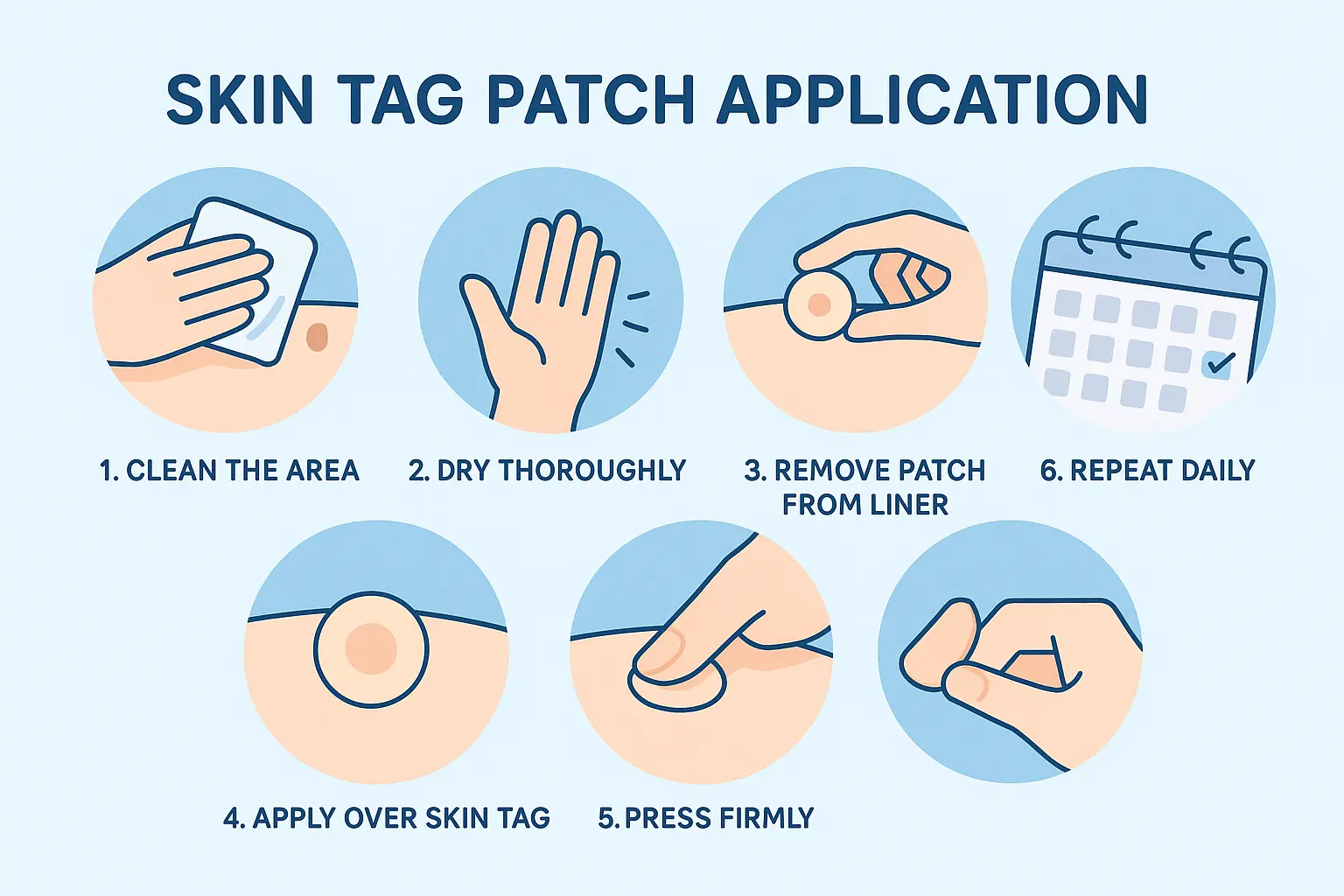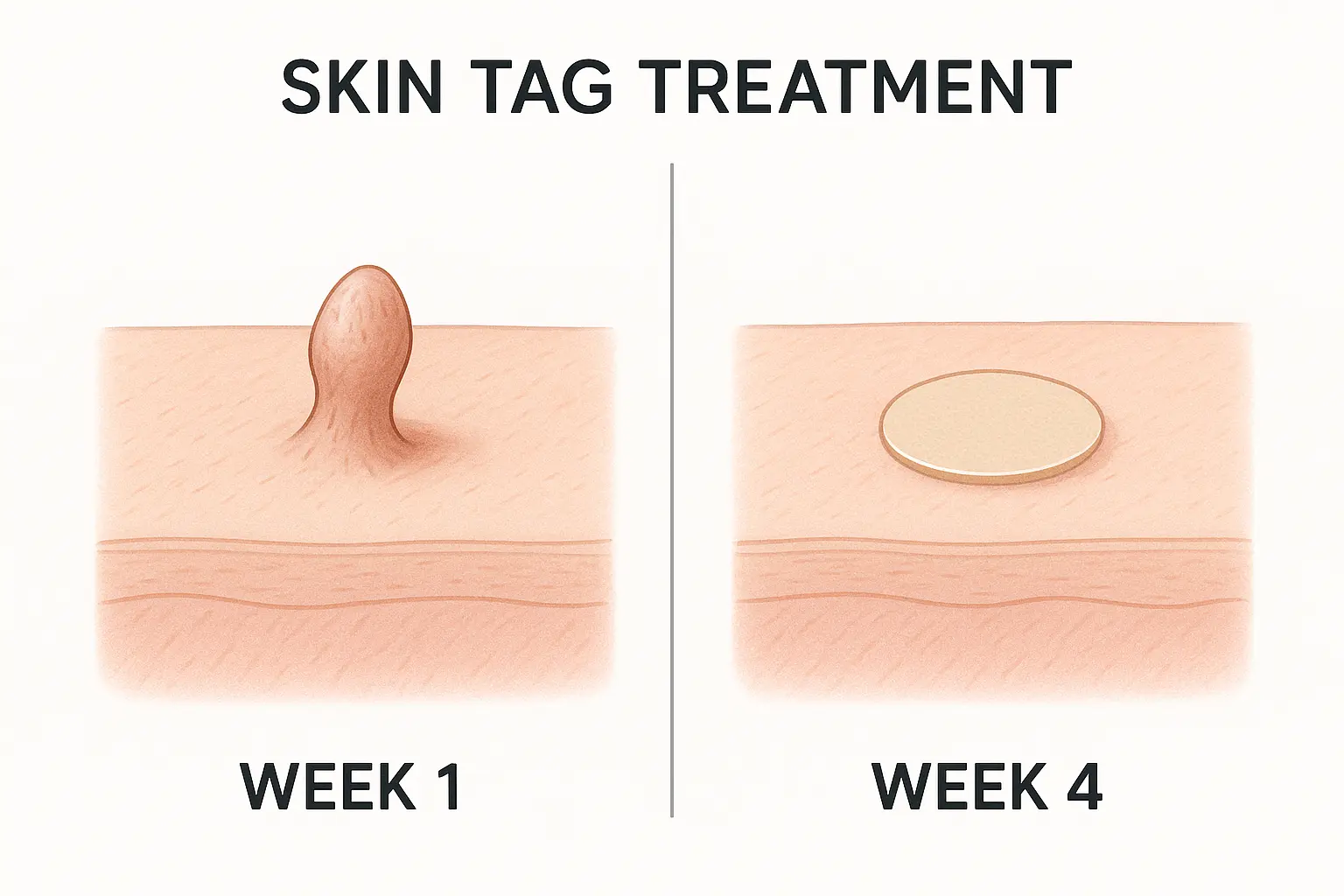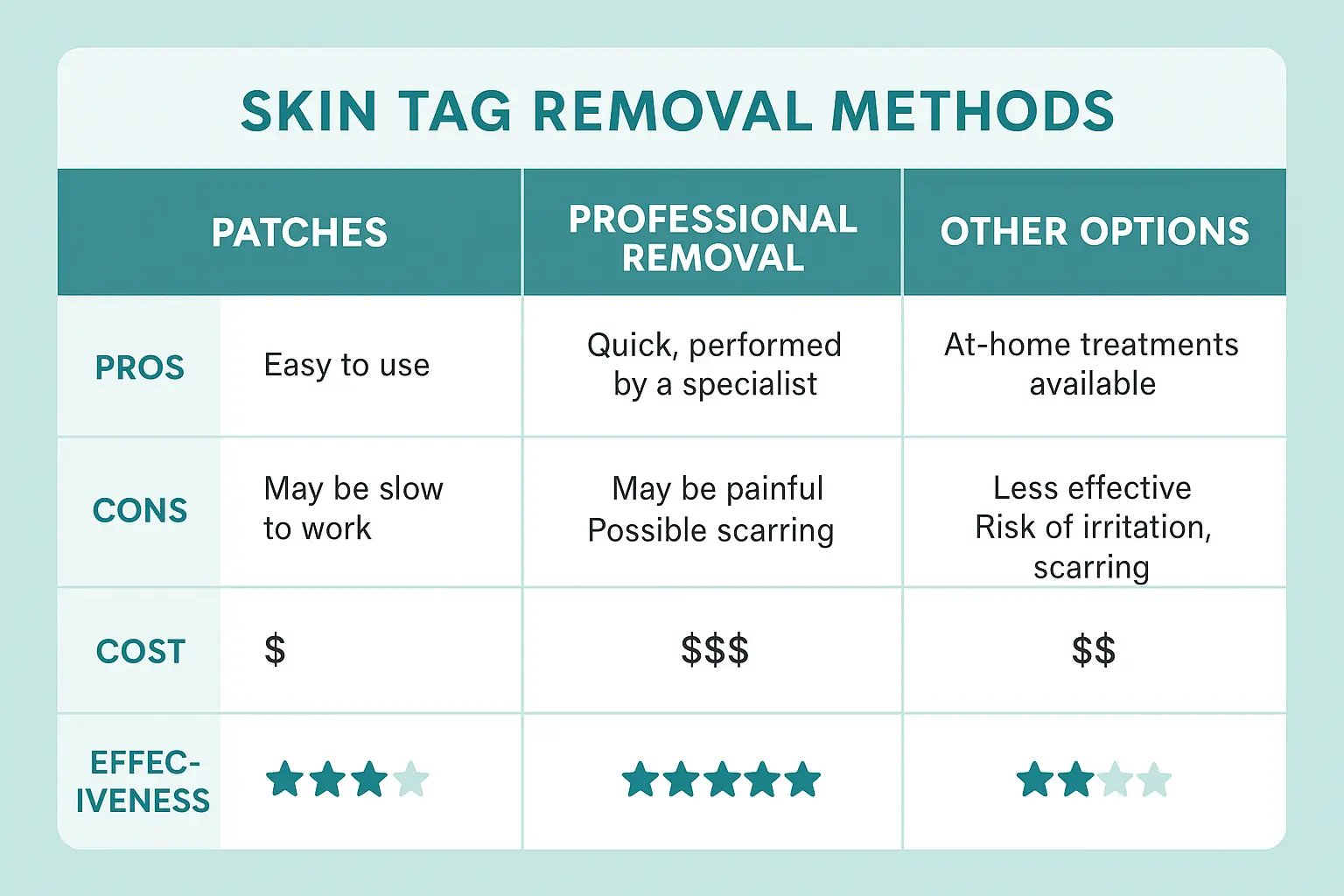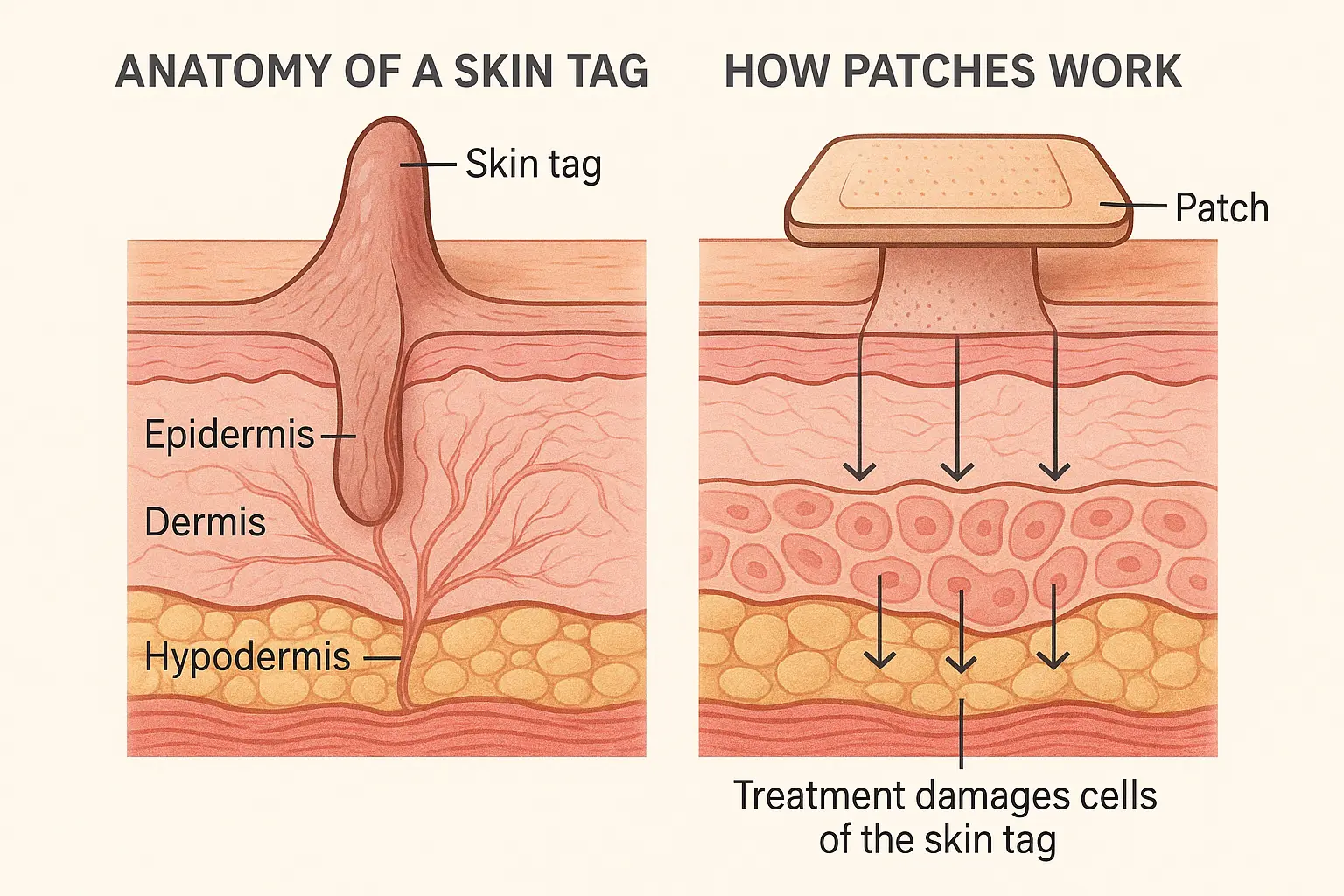Imagine looking in the mirror and feeling completely confident in your skin—no more hiding those small, annoying growths that seem to appear out of nowhere. If you're dealing with skin tags, you're not alone. These harmless but bothersome skin growths affect millions of people, and thankfully, skin tag patches have emerged as a popular, non-invasive solution that you can use from the comfort of your own home.
• Skin tag patches are adhesive treatments containing active ingredients like salicylic acid that gradually remove skin tags over 2-4 weeks
• They're most effective on small to medium-sized skin tags (under 5mm) and work best when applied consistently
• Professional removal remains the gold standard for larger, irritated, or concerning skin tags
• Proper preparation and aftercare are essential for successful patch treatment and preventing infection
• Always consult a healthcare provider if you're unsure whether a growth is actually a skin tag
Skin tags, medically known as acrochordons, are small, soft pieces of hanging skin that typically appear in areas where skin rubs against skin or clothing. These benign growths are incredibly common—studies show that up to 60% of adults will develop at least one skin tag during their lifetime.
Skin tags tend to develop in areas with frequent friction:
Several factors contribute to skin tag development:
Friction and Irritation: Constant rubbing from clothing, jewelry, or skin-to-skin contact creates the perfect environment for skin tag formation.
Hormonal Changes: Pregnancy, diabetes, and hormonal fluctuations can increase your likelihood of developing skin tags.
Genetics: If your family members have skin tags, you're more likely to develop them too.
Age: Skin tags become more common as we age, with most appearing after age 40.
Weight: Areas with skin folds are more prone to friction, making skin tags more likely in people who are overweight.
Skin tag patches represent a modern approach to at-home skin tag removal. These small, adhesive patches contain active ingredients designed to gradually break down the skin tag tissue over time.
Most effective skin tag patches contain one or more of these key ingredients:
IngredientHow It WorksEffectivenessSalicylic AcidBreaks down skin cells and promotes sheddingHigh for small tagsLactic AcidGently exfoliates and softens tissueModerateTea Tree OilNatural antiseptic with mild caustic propertiesLow to moderateCopper PeptidesPromotes healing while breaking down tissueModerate
Skin tag patches work through a process called controlled tissue breakdown. The active ingredients penetrate the skin tag tissue, gradually weakening the cellular structure until the tag naturally falls off. This process typically takes 2-4 weeks with consistent application.
"The key to successful patch treatment is patience and consistency. Unlike surgical removal, patches work gradually to minimize scarring and discomfort." - Dermatology Research Journal, 2025

The market offers several varieties of skin tag patches, each with unique features and benefits:
These are the most common type, featuring a small adhesive pad pre-loaded with active ingredients.
Pros:
Cons:
These innovative patches use tiny, dissolvable needles to deliver active ingredients directly into the skin tag tissue.
Pros:
Cons:
Made with plant-based ingredients like tea tree oil, these patches appeal to those seeking natural alternatives.
Pros:
Cons:
Success with skin tag patches depends heavily on proper application and consistent use. Here's your step-by-step guide:
1. Clean the Area Thoroughly Use mild soap and water to clean the skin tag and surrounding area. Pat dry completely—moisture can prevent proper patch adhesion.
2. Assess the Skin Tag Measure the skin tag to ensure it's suitable for patch treatment. Most patches work best on tags smaller than 5mm in diameter.
3. Gather Your Supplies
Step 1: Remove the Patch Carefully peel the patch from its backing, avoiding contact with the adhesive side.
Step 2: Position Accurately Center the patch directly over the skin tag, ensuring complete coverage without overlapping onto healthy skin.
Step 3: Press Firmly Apply steady pressure for 10-15 seconds to ensure proper adhesion.
Step 4: Smooth Edges Gently smooth the patch edges to prevent lifting or catching on clothing.
WeekWhat to ExpectAction RequiredWeek 1Slight darkening of skin tagReplace patch every 2-3 daysWeek 2Tag begins to shrink and dryContinue regular replacementWeek 3Significant reduction in sizeMonitor for irritationWeek 4Tag falls off naturallyBegin aftercare routine
With numerous options available, selecting the best skin tag patches for your needs requires careful consideration of several factors:
Small Tags (1-3mm): Most patches work well Medium Tags (3-5mm): Look for larger patch sizes or stronger formulations Large Tags (5mm+): Consider professional removal options instead
If you have sensitive skin, prioritize patches with:
Visible Areas (Face, Neck): Choose discreet, flesh-toned patches High-Friction Areas: Opt for extra-strong adhesive formulations Sensitive Areas: Select gentler, natural ingredient patches
✅ FDA-registered facilities ✅ Clear ingredient lists ✅ Positive user reviews ✅ Money-back guarantees ✅ Dermatologist recommendations

While skin tag patches are generally safe when used correctly, it's important to understand potential risks and how to minimize them.
Mild Skin Irritation 🔴
Contact Dermatitis
Hyperpigmentation
Discontinue patch use immediately if you experience:
Certain individuals should consult healthcare providers before using patches:
Understanding how skin tag patches stack up against other removal options helps you make an informed decision about the best approach for your situation.
Advantages:
Disadvantages:
The Minor Surgery Center specializes in quick, professional skin tag removal with expert care and minimal wait times.
Advantages:
Disadvantages:
Advantages:
Disadvantages:
Advantages:
Disadvantages:
Proper application technique significantly impacts the success of your skin tag patch treatment. Follow this detailed guide for optimal results:
Before applying your first patch, ensure you have:
Phase 1: Preparation (5 minutes)
Phase 2: Application (2 minutes)
Phase 3: Post-Application Care
Problem: Patch Won't Stick
Problem: Patch Causes Immediate Irritation
Problem: Skin Tag Too Large for Patch

Understanding the typical progression of skin tag patch treatment helps set realistic expectations and identify when intervention might be needed.
Days 1-3: Initial Response
Days 4-7: Early Changes
Days 8-14: Visible Progress
Days 15-21: Significant Changes
Days 22-28: Final Stage
Several variables influence how quickly skin tag patches work:
Skin Tag Characteristics:
Individual Factors:
Treatment Consistency:
Proper aftercare following skin tag patch treatment is crucial for optimal healing and preventing complications.
Keep the Area Clean
Monitor for Complications
Protect the Healing Skin
Week 1 Post-Treatment:
Weeks 2-3:
Week 4 and Beyond:
Normal Healing Signs: ✅
Warning Signs: ⚠️
If you experience any warning signs, contact a healthcare provider immediately.
Understanding the financial implications of different skin tag removal methods helps you make an informed decision that fits your budget and needs.
Initial Investment:
Long-term Considerations:
Typical Professional Fees:
Value Considerations:
MethodInitial CostSuccess RateTime InvestmentTotal ValuePatches$20-6060-80%4-6 weeksModerateProfessional$150-40095-99%1 visitHighMultiple Patches$40-120Variable8-12 weeksLow
For multiple skin tags or larger growths, professional removal often provides better long-term value.

While skin tag patches work well for many situations, certain circumstances warrant professional medical treatment for optimal results and safety.
Size Considerations
Location Factors
Medical Considerations
Immediate Results: Professional removal provides instant, complete elimination of skin tags without the weeks-long treatment process required by patches.
Medical Supervision: Having a qualified professional perform the procedure ensures proper technique, sterile conditions, and immediate management of any complications.
Suitable for All Sizes: Unlike patches, which work best on smaller tags, professional removal can handle skin tags of any size effectively.
Minimal Scarring: When performed correctly, professional removal typically results in less scarring than failed at-home treatments.
The Minor Surgery Center specializes in quick, efficient skin tag removal with minimal discomfort. The process typically involves:
Understanding how to prevent skin tags can save you from future treatment decisions and help maintain smooth, healthy skin.
Reduce Friction
Maintain Healthy Weight
Manage Underlying Conditions
Keep Skin Dry
Gentle Skin Care
Monthly Skin Checks
Professional Evaluation
For comprehensive skin health evaluation and prevention strategies, consider scheduling a consultation through our clinic.
Most skin tag patches require 2-4 weeks of consistent use to achieve complete removal. Smaller skin tags typically respond faster than larger ones, with some showing results in as little as 10-14 days.
While generally safe, patches may cause irritation in people with sensitive skin. Those with darker skin tones should be particularly cautious about potential hyperpigmentation. Always test on a small area first.
Yes, you can treat multiple skin tags simultaneously, but monitor each site carefully for signs of irritation. Start with one or two tags to assess your skin's response before treating more.
If a skin tag partially responds but doesn't fall off completely after 4-6 weeks, discontinue patch use and consult a healthcare provider. Attempting to remove it manually can cause infection or scarring.
Patches work best on areas with relatively thick skin and good adhesion. They're less effective on very thin skin areas like eyelids or areas that get very wet frequently.
Patch treatments typically cost $15-60 for a complete treatment cycle, while professional removal ranges from $100-400. However, patches may require multiple attempts, potentially making professional removal more cost-effective in some cases.
Properly removed skin tags don't typically grow back in the exact same spot. However, new skin tags can develop in the same area due to ongoing friction or other factors.
Choosing between skin tag patches and professional removal depends on your specific situation, preferences, and risk tolerance.
✅ You have small to medium-sized skin tags (under 5mm) ✅ Cost is a primary concern ✅ You prefer gradual, at-home treatment ✅ The skin tags are in non-sensitive areas ✅ You have time for a 4-6 week treatment process ✅ You don't have underlying health conditions affecting healing
✅ You have large skin tags (5mm or larger) ✅ You want immediate results ✅ The skin tags are in visible or sensitive areas ✅ You have multiple skin tags to remove ✅ You have diabetes or other health conditions ✅ Previous patch treatments have failed ✅ You're concerned about scarring or complications
Some people benefit from a combined approach:
Skin tag patches offer a convenient, cost-effective solution for many people dealing with small to medium-sized skin tags. When used correctly and consistently, they can provide safe, effective removal without the need for professional intervention.
However, it's important to recognize when professional care is the better choice. The Minor Surgery Center provides expert skin tag removal with the compassion and efficiency you deserve. No long wait times, no complicated referrals—just professional care that gets you feeling confident in your skin again.
Remember, your skin health is important, and there's no shame in seeking professional help when you need it. Whether you choose patches or professional removal, the goal is the same: helping you feel comfortable and confident in your own skin.
For more information about skin conditions and treatment options, visit our comprehensive conditions page or explore our blog for additional helpful resources.
Skin tag patches represent a valuable option in the spectrum of skin tag removal methods, offering an accessible, at-home solution for many people. While they're not suitable for every situation, they can be highly effective when used appropriately on small to medium-sized skin tags.
The key to success with skin tag patches lies in:
Whether you choose to start with patches or opt for professional removal from the beginning, the most important thing is taking action to address skin tags that bother you. You deserve to feel confident and comfortable in your skin, and both options can help you achieve that goal.
If you're unsure about the best approach for your specific situation, don't hesitate to contact our team for professional guidance. We're here to help you make the best decision for your skin health and peace of mind.